|
Welcome
To My Tools Page.
This page is to show some of the tools that I use
in making up my figures, these are not all of them as I have amassed a few other
useful pieces over the years. But these are the most common tools that I have
been using with my 1/6th scale figures. I have numbered each item and given a
description below on how I find them useful.
Note: A lot of
this may be very familiar to a lot of modellers, but I do hope that this page
can help you in some way.
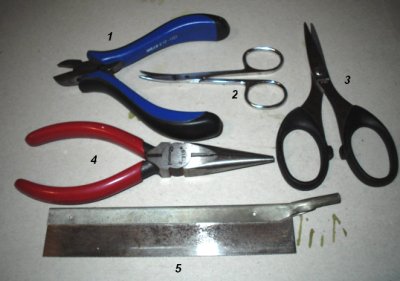
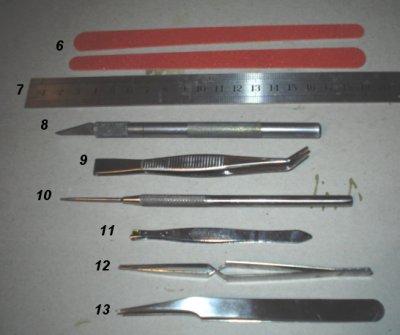
1 - Wire Cutters - These are useful for
cutting the wire that hold the figures and pieces in place in the boxes, also
for trimming belts, webbing ends and any thin wire cutting.
2 - Curved End
Scissors - I use these for cutting out insignia and any fine cutting work.
3
- General Use Scissors. 4 - Pointed Pliers - These are very useful
for holding any wire that I want to cut up, also for folding the clips that hold
the US equipment onto a webbing belt. 5 - Razor Saw - This is used for
any fine sawing work I have to do.
6 - Emery
Boards - These are used for fine sanding work. 7
- Long Steel Ruler - Mainly used for measuring webbing straps before any cutting
to length. 8 - Modelling Knife - This is my trusty
knife that I use for almost all the cutting jobs I have to carry out.
9 - Angle Nose Tweezers - Mainly used for
getting into tricky spaces under equipment on a completed figure to fasten any
loose clips. 10 - Dental Probe - This is
mainly used to make any small holes in material. 11
- Flat Nosed Tweezers - Mainly used when the pointed tweezers cannot grip the
piece I am working on. 12 - Reverse Action
Tweezers - These work by pressing them to open them, I have found these very
handy at times when I am working on small parts which need to be held in place,
while I am using the pointed tweezers. 13 - Pointed Tweezers - This is my main
tool that I use for my figures, as it helps immensely to undo straps or clips
without damaging them. They also come in handy for enlarging the holes in the
DiD US helmet liners, where the pin for the webbing strap goes.
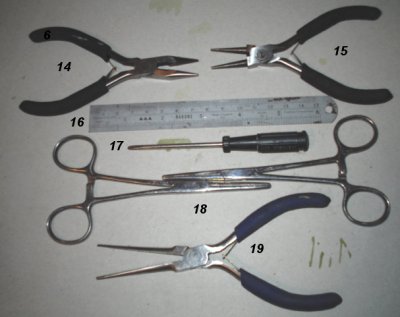
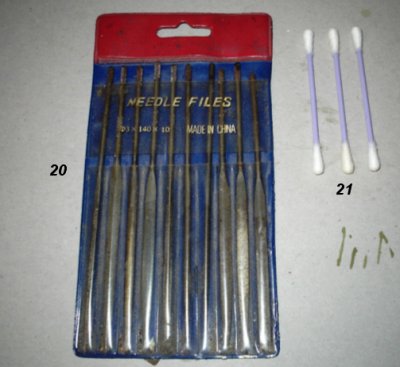
14 - Smaller
short Pointed Pliers - These are very used again
for holding any wire that I want to cut up. 15
- Pointed Circlip Pliers - I have used these to open up any wire parts I am
working on, plus I also use them to shape circles in the wire.
16 - Short Steel Ruler.
17 - Small Flat Screwdriver.
18 - Locking Forceps - Useful for holding
wire ends, rather than have it stick into my fingers.
19 - Long Nose Fine Pliers - These are mainly used for fastening
clips on equipment on the finished figure, and they give me a bit more leverage
than the tweezers. 20 - Needle Files - Used
for any filing or heavy sanding work I have to do. 21
- Cotton Buds - I use these with the
Tamiya weathering powders, because the pad
that is supplied in the pack tends to split and I find it hard to use so these
are a replacement for it.
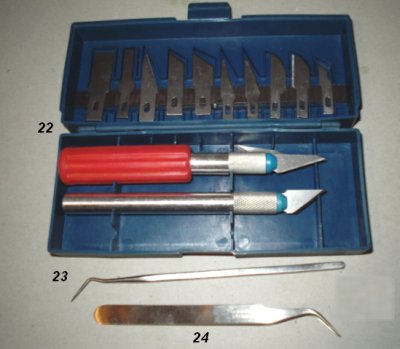
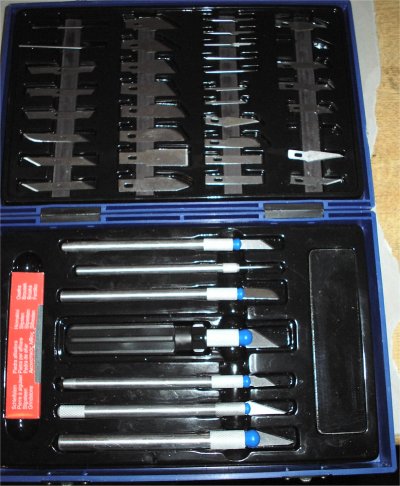
22 - Small
Model Knife Set - I bought this set as it was cheaper than buying the
replacement blades for my model knife, plus I also have two heavier handles for
any awkward work. 23 - Angled Dental Probe -
Again used for making holes in material. 24
- Angled pointed Tweezers - Used for fine intricate work with clips under the
assembled equipment.
25 - Large
Model Knife Set - This again was bought for the blades, as I have found that
over the years you can never have enough knife blades. And at the time this set
was for sale, the cost of it was about the price of 4 good sets of single
pointed blades, but with this set I have a variety of types.
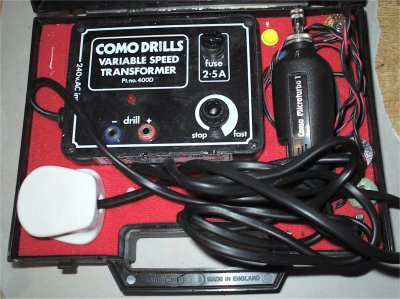
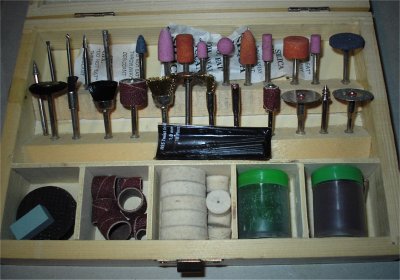
26 - Variable
Speed Model Drill - I have had this for a good few years now and I have found it
useful for a variety of uses, especially with the speed adjustment on it.
27 - Various Model Drill Bits - This was
another sort of lucky find which at the price was just too good to pass up on,
the only things that I have added to it are the very fine drill bits.
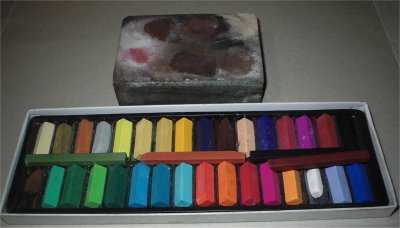
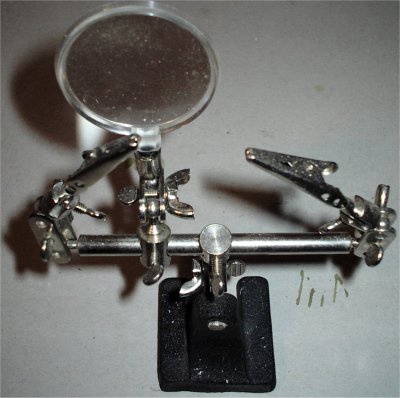
28 - Pastel
Chalks - I bought these to use on the uniforms on my figures, I have used a few
of them mainly the browns and greens and I have found through experience that a
lot of them will be wasted. So it might be better to buy the chalks individually
instead of in a set like this. Above the chalks is a foam sanding pad, I have
used this for about 2 years to mix the ground up pastel chalks on, I also
sometimes add some water onto the pad, then mix this with the chalk to get the
'blend' for the pastel washes I give my figure's headsculpts.
29 - 'The
Third Hand' - This I have found very useful when I have painted my rifles, as I
can use the clips to hold the rifle secure without me having to move it around
to paint it. This has the benefit of making sure that I don't smudge any paint
with my fingers.

30
- Humbrol Liquid Poly Glue - This is the main glue I use for any plastic repairs
on my figures and weapons, although I do also use Superglue at times. But I
prefer to use this type on any plastic parts as it 'melts' the parts together
making a stronger bond.
31 - Poly Glue
'Mix' - This pot is a mix of the poly glue and scraps of plastic such as sprue
added to it, the purpose of this is that the glue melts down the plastic over
time to make a liquid plastic.
I found out about this many many years ago and it
has helped me enormously with my 1/35th and 1/48th scale models, because when it
is brushed onto a joint seam and smoothed down with the normal poly glue. Once
it hardens it becomes part of the model
itself, and I have found that with 1/6th scale weapons if I have broken them in
some way this glue can repair them far
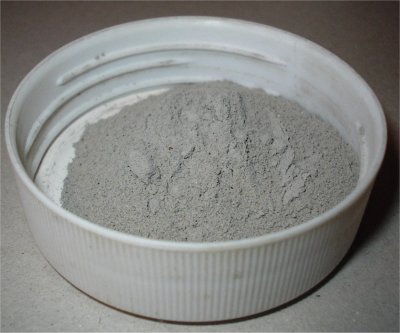 better than Superglue ever could. better than Superglue ever could.
32 - This
is the new packaging for the Humbrol glue, whereas the other smaller bottles are one's
that I have had around for years.
33 - Tiling
Grout - This tip was passed onto me by Terry and I have found it very useful for
adding a dusty look to my figures, plus I have found that it mixes well with the
ground down pastel chalks to give a variety of different colours.
Note: This creates a very fine dust so a
face mask is advised if you are using it, or use it in a well ventilated area.
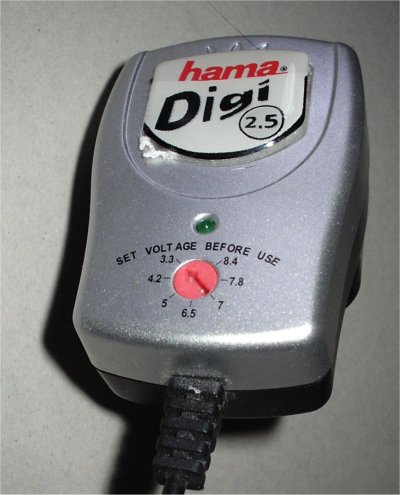 34 -
Mains Adapter For My Digital Camera - This is one of the most useful items I
have for making my models, because before I had this I found I was using up a
lot of batteries to take the pictures for this website. It took me a while to
find this particular adapter because the camera needs a 3.3v power supply, and
it was only by pure luck that I found a shop that sold this one with a
selectable voltage rating. 34 -
Mains Adapter For My Digital Camera - This is one of the most useful items I
have for making my models, because before I had this I found I was using up a
lot of batteries to take the pictures for this website. It took me a while to
find this particular adapter because the camera needs a 3.3v power supply, and
it was only by pure luck that I found a shop that sold this one with a
selectable voltage rating.
35 -
Paintbrushes - With these items I have found over the years that it is best to
go with the natural hair types, and stay away from the nylon type as they are
too rough for any real model painting work. Altogether I think I must have over
20 brushes of various sizes and with the smaller one's it is always best to pay
that little bit extra, especially with painting the 1/6th scale weapons. With
the larger type like the Fan brushes which I use for dusting the uniforms with
pastels these have over time become quite worn, but to continue using these for
this rough work I have found that all I do is just cut the bristles level at the
end and they can still be used. I have also found as the bristles on the large
brushes have worn down, I can get a better scrubbing action with the pastels and
the grout I use.
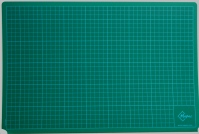 35 - A4
Cutting Mat - I have had one like this for some years now and is very handy for
cutting items on, as it is self healing and it protects my desk top from any
damage such as knife blades and paint. 35 - A4
Cutting Mat - I have had one like this for some years now and is very handy for
cutting items on, as it is self healing and it protects my desk top from any
damage such as knife blades and paint.
36 - Superglue
- This can be very handy with my models, but to hold anything together it is a
last resort method. The best use I have found for this over the years with my
modelling, is a means to stop any bleeding from any cuts I have if I slip with
my model knife. As all i do is clean up the injured area, dry it and slow down
the bleeding and drop some of the superglue over the cut, press down with a
finger to seal it, remove the finger and wait for it to dry.
| 
